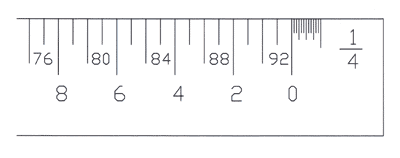
I know you all have been waiting with bated breath to see what comes next (kidding). Not much actually. It actually took me many weekends to even get back in the sewing room. I think I just needed a little vacation from all my hobbies.
I also had sinus crud and we went on a lovely mini-vacation, so I haven't been feeling well and/or around to do anything.
I have now sewn one shirt and made one more drawer.
So, it will be boring stuff for a while, but I thought I would share my favorite new tool that I discovered when I started woodworking: The Architect's Scale

This nifty little ruler can be quite annoying if you don't know how to use it, but when you do, it can save a lot of time.
The most confusing part of the ruler is that it's really 11 scales in one. There are three sides, and each side has a bottom and top, and all but one of the top/bottoms has two scales on it. Here's a close up of just one bit:
 The 1/4 tells you what scale that side is. Next, look for the zero. That's tells you which of the numbers lines you want to read. In the example above, we want to completely ignore the numbers 76-92. Those are coming from the other side of the ruler. Instead we're going to look at 0 - 8. It means we will have to read numbers right to left, but that's not too hard, and by flipping the ruler over we can get another scale.
The 1/4 tells you what scale that side is. Next, look for the zero. That's tells you which of the numbers lines you want to read. In the example above, we want to completely ignore the numbers 76-92. Those are coming from the other side of the ruler. Instead we're going to look at 0 - 8. It means we will have to read numbers right to left, but that's not too hard, and by flipping the ruler over we can get another scale.The other idiosyncrasies of the ruler that make it annoying don't bother me once I understand why. For instance: why can't the zero just be on the end? That's to keep the marks on the end from getting messed up.
And what's with the marks to the right of the zero? Two reasons, as far as I see it. First, if the ruler was to have the divisions between the numbers it would become even more unreadable. Second, look closely, those dashes aren't breaking it up into 10ths (as metric rulers do) or 16ths (as imperial rulers do). Instead, it's twelve parts (as in 12 inches to a foot). So, you don't even have to convert the feet to inches or the inches to parts of a foot. Just add the number of divisions past the zero and you have your inches.
Anyway, I've found the scale really useful. I used the 3/32" scale when drawing out my room, 3/16" for the pieces of furniture and 1/8" when drawing smaller pieces (like the drawers) so I could see the joins clearly.
There are some longer tutorials online like this one (it's where I got the close up images from)
No comments:
Post a Comment